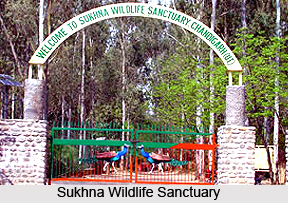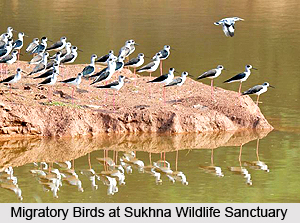 Sukhna Wildlife Sanctuary is situated in Chandigarh, forming a part of Sukhna Lake catchment area in the Shivalik hills. Spanning over an area of 2600 hectares, the place is quite unstable geographically and becomes prone to soil erosion by surface run off during rains. The region is also known for being ecologically sensitive. Sukhna Wildlife Sanctuary has sandy soil of Shivaliks with pockets of clay embedded at places. The sanctuary is the habitat for a large species of flora and fauna.
Sukhna Wildlife Sanctuary is situated in Chandigarh, forming a part of Sukhna Lake catchment area in the Shivalik hills. Spanning over an area of 2600 hectares, the place is quite unstable geographically and becomes prone to soil erosion by surface run off during rains. The region is also known for being ecologically sensitive. Sukhna Wildlife Sanctuary has sandy soil of Shivaliks with pockets of clay embedded at places. The sanctuary is the habitat for a large species of flora and fauna.
History of Sukhna Wildlife Sanctuary
Sukhna Lake was created in 1958. During early seventies it was observed that the siltation rate of the lake was quite high owing to the heavy soil erosion in the catchment area. By the year 1988, the lake lost its 66 percent of the original water holding capacity because of siltation. To control the soil erosion, the Forest Department adopted a number of engineering and vegetative techniques which proved quite effective in reducing the rate of soil erosion from hilly catchment area. Massive afforestation was a crucial step in the conservation measures taken which resulted in the development of a dense forest area sheltering a vast variety of fauna. This area later came to be known as Sukhna Wildlife Sanctuary.
 Soil Conservation in Sukhna Wildlife Sanctuary
Soil Conservation in Sukhna Wildlife Sanctuary
To reduce the susceptibility of soil erosion in the sanctuary two major initiatives have been taken. Engineering methods for soil conservation include construction of check dams, retention dams, brushwood structures, revetments and spurs. Regular desiltation of water bodies and dumping the silts on appropriate sites is another step in conservation methods. Vegetative methods include extensive afforestation with sowing of seeds in trenches and hill slopes. Plantation of various herbs, shrubs and trees maintaining a high density of vegetation is another efficient technique.
Improving Biodiversity in Sukhna Wildlife Sanctuary
Initially Sukhna Wildlife Sanctuary was covered with lantana weed which is one of the most obnoxious weeds found in Shivaliks and the surrounding forests of Chandigarh. Its growth was a serious threat as this hard weed hindered the growth of other vegetations and damaged other trees. This severely affected the biodiversity of the forest. To combat this trouble, a seven years schedule was planned by the Forest Department of Chandigarh Administration in March, 2001 to eradicate the growth of lantana from the forest. The project succeeded by 2008-09 and made the forest completely free from lantana. It helped greatly in improving the wildlife habitat of the sanctuary, developing grazing grounds for wildlife and eliminating the threat of forest fire.
 Flora and Fauna of Sukhna Wildlife Sanctuary
Flora and Fauna of Sukhna Wildlife Sanctuary
Sukhna Wildlife Sanctuary shelters a vast species of flora and fauna. The huge variety of flora in fact forms an excellent habitat for the wildlife of the forest. Common flora of the sanctuary include Khair, Phulai, Kikar, Shisham, Moonj, Amaltas, Jhingan, Amla, Rati, Vasaka and many more. Fauna of the sanctuary includes different species of mammals, birds, reptiles and insects. Squirrel, Common-Mongoose, Indian Hare, Porcupine, Jungle Cat, Jackal, Wild boar etc are the mammals found in the sanctuary whereas Peacock, Hill myna, Jungle crow, Black drongo, Parrots, Doves, Barn owls, Woodpeckers, Cuckoos and others are the common birds of this region. Migratory birds also flock around this place. Reptiles of this sanctuary are Turtle, Common Monitor, Indian Python, Common Krait, Snake, Rat etc while insects of the forest include Honey-bee, Moth, variety of Butterflies and other microorganism.
Eco Tourism in Sukhna Wildlife Sanctuary
Nature trails have been created in the sanctuary by the Department of Forests and Wildlife, Chandigarh Administration for promoting ecotourism and creating awareness among the people about the rich natural heritage of the country. These trails take the visitors through various hill slopes, woods and water bodies and let them interact with the vibrant wildlife of the sanctuary. They also give an idea about the soil conservation and management techniques prevailing in the region. Along the nature trails, watchtowers have been constructed which provides a panoramic view of Shivalik hills. Boating can also be enjoyed in the water bodies.



















